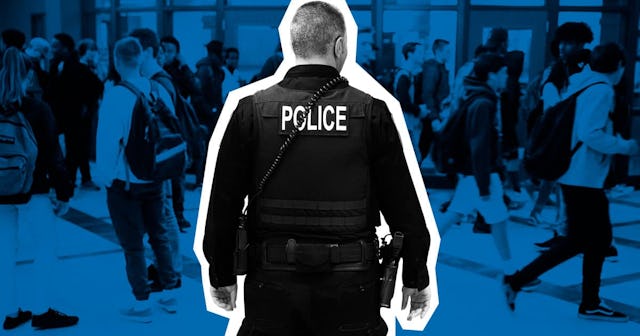Portland And Minneapolis Remove School Resource Officers – Why Other Schools Should Follow Suit

Thousands have taken to the streets to protest police brutality in the days after George Floyd’s death at the hands of officer Derek Chauvin. The protests have swept through every state in America, and have circled the entire globe. The protests have started conversations long overdue and have begun to enact changes long called for, but ignored.
One such change: removing school resource officers from schools.
This week, the Minneapolis School Board voted unanimously to end its relationship with the Minneapolis Police Department. Just days later, Portland Public Schools also voted to discontinue the regular police presence in the state’s largest school district.
The announcements were met with cheers from activists who’d been working to end the police presence in schools, and horror by opponents who believe police in school is the same thing as safety in school.
Only, when you look at the facts, that belief isn’t supported. And in fact, if we really want to make our schools safer, more schools should follow the lead of Portland and Minneapolis.
Marc Schindler, head of the Justice Policy Institute, said in a 2018 interview with NPR with respect to whether expanding law enforcement within schools creates safer schools, “In fact, the data really shows otherwise — that this is largely a failed approach in devoting a significant amount of resources but not getting the outcome in school safety that we are all looking for.”
The presence of law enforcement in schools started to grow in the 1990s, especially after the 1999 Columbine shootings. Now, as many as 20,000 student resource officers walk the halls of America’s schools, presumably to deter school shootings. However, a 2013, Congressional Research Service report concluded that “the body of research on the effectiveness of SROs does not address whether their presence in schools has deterred mass shootings.” In fact, a school resource officer was on the scene at the time of the Marjory Stoneman Douglas High School in Parkland, Florida in 2018, when a gunman killed seventeen people.
The sad truth is a deadly virus circulating through our cities and neighborhoods has done more to prevent school shootings than student resource officers.
While evidence regarding the effectiveness of school resource officers to deter school shootings is limited, the stories and evidence otherwise—that school resource officers have negative, unintended consequences—are hard to ignore.
In one particularly troubling story, a six-year-old in Florida was arrested for having a temper tantrum in school. Six years old! When my son was six, he’d just lost his father and he was acting out in school, having temper tantrums that left me at a loss for words. What he needed was a grief counselor. Not an arrest record. My guess is the Florida six-year-old similarly needed an adult to help her, rather than criminalize her.
According to Schindler, schools with a police presence have higher rates of suspensions, expulsions, and arrests that funnel kids into the criminal justice system. A fact that is especially true in schools attended predominantly by students of color. A report from the Education Department found that Black students are 2.2 times more likely than white students to be either referred to police or arrested during school hours.
The Washington Post/Getty
In cases that don’t result in arrest, the disciplinary action frequently turned to is suspension. According to Dr. Edward M. Morris, a professor of Sociology at the University of Kentucky, each suspension can decrease a kid’s achievement growth by nine points, and it’s nearly impossible to truly catch up.
On the contrary, schools that invest in mental health see improved attendance, academic achievement, and graduation rates, according to a report from the American Council of Education. These services can identify children who need support; they can identify and prevent the situations that police officers can only respond and react to—because that’s all they were trained to do.
But most schools don’t have those crucial services. The ACLU found that 1.7 million students are in schools with police but no counselors, and 3 million students are in schools with police but no nurses, and 14 million students are in schools with police but no counselor, nurse, psychologist, or social worker.
The Minneapolis school board’s decision to remove school resource officers frees up $1 million in funding, to go to crucial school-based mental health services, proven to help kids and increase safety in schools. Similarly, Portland’s move to eliminate armed police officers from schools will allow the city to transfer $1 million to support other “community-driven” programs.
To summarize: school resource officers haven’t been shown to deter school shootings, and they tend to have a negative effect on students, particularly students of color — whereas spending more on counselors and social workers positively affects schools.
Given all of that, it’s obvious why Minneapolis and Portland made the decisions they made. They didn’t make their choice to jump on some anti-police bandwagon. They made the choice because the evidence showed that the current policy was hurting more than helping, and because they decided to invest in their students.
Make no mistake, I want my children to be safe. I hate that when I send them off to school (back in those days pre-COVID-19 when we sent kids to schools) I can’t help but to worry that they won’t be safe, that too many people with guns have found their way into too many schools. But I don’t want the illusion of safety for my kids. I want real safety, which means channeling funding into social workers, who talk about bullying, and school nurses and counselors, who can de-escalate a situation or identify at-risk students.
It’s time more schools followed the lead of Minneapolis and Portland, because instead of a police presence to react, we need real support to proactively prevent.
This article was originally published on